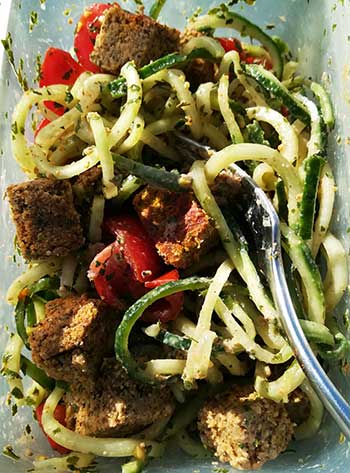A Healthy Lunchbox Strategy

Packing a lunchbox with healthy foods to fuel physical and mental activities through the workday requires some thought. Considerations include your work environment and your digestive system; for example, having enough time to eat in a relaxed manner, away from your work area, and preferably in a stress-free environment.
Taking the time to pack your own lunchbox can help to ensure a well-balanced meal that includes a quality source of protein, healthy fat, and complex carbohydrates for sustained energy release throughout the day. Overly processed foods, sugary snacks and too much caffeine can cause energy to crash, which can leave you feeling tired, unmotivated and irritable.
My healthy lunchbox strategy has 3 main concerns:
- Satisfy my hunger – if I enjoy what I eat I am more likely to be satisfied.
- Provide enough energy to last until the evening meal, which means including some slow burning complex carbohydrates such as vegetables, whole grains and beans. Good fats are also important for fuelling the brain, which can mean hemp seeds, walnuts or ripe avocado.
- Avoid creating digestive upsets – most of us do not have the time to take a nap after lunch so eating foods that are easy to digest and in a way that facilitates digestion, will reduce the likelihood of flatulence, cramping or other digestive upsets.
Choosing easy to digest foods means more energy to fuel you through the rest of the day.
Heavy proteins such as meat, cheese and eggs take a lot of energy and are slow to digest. If you are opting for meat, go for simply prepared fish, chicken, or lean cuts of meat, which will be easier on your digestive system than more fatty cuts.
The average amount of time allotted for lunch tends to be about an hour. I like to allow myself the time to eat slowly and truly enjoy the food I am eating. The brain and stomach are interrelated. Digestion is impaired if we eat while stressed or anxious. I prefer to eat lunch away from my work area, digital and other distractions. There are times when stress is unavoidable, and on those days lunch will be either raw fruit, vegetable soup, or a light salad.
There’s a wise saying: “Eat fruit on its own or leave it alone.” This is because fruit digests faster than vegetables, grains, legumes, nuts, seeds or meats, and other foods. So eating fruit on its own, or at least 15 minutes before a meal ensures it will not get trapped behind slower moving food, ferment in the gut and cause flatulence, cramping, or other digestive upsets.
If I have a mix of raw and cooked foods then I eat the raw foods first. Why?—because they digest faster than cooked foods. Imagine your digestive tract as a one-way country lane. The slow to digest foods are like a tractor that is completely blocking the road and moving at a snail’s pace. The faster and easier to digest foods are like race cars, eager to move but stuck behind the tractor, which after a few miles are likely to start making noise. If you are prone to digestive upsets pay attention to the varying digestive times your food needs.
General Guidelines
- Raw fruits: 20-40 minutes
- Light soups juices and smoothies: 30-45 minutes
- Vegetables: 30-60 minutes depending on variety and cooking method. For example steamed spinach will digest in 30 minutes while potato salad would need about an hour
- Whole and pseudo grains such as brown rice, millet, buckwheat and quinoa need about 90 minutes, while the more starchy white pasta and rice can take from 2 to 3 hours.
- Beans, which are a great addition to salads and help you to feel fuller for longer, require about 90 minutes.
- Seeds and nuts are a great source of minerals and Omega 3 fatty acids to fuel the brain and assist concentration, and need from 2 to 3 hours to digest.
- Steamed white fish needs less time than lighter meats such as poultry which needs 2 or more hours.
- Heavier meats such as lamb and pork would need 4 or more hours and can use up more energy on digestion than they can deliver in the work day.
- A glass of whole milk and a ham and cheese sandwich could require 4 to 5 hours to digest. In contrast, a boiled egg needs only 45 minutes.
A common mistake made by busy professionals is to skip lunch and snack every couple of hours. When this happens, the stomach stops what it is currently digesting and starts digesting the incoming food. In this way, digestion is continuously interrupted; the food that is neglected begins to ferment and cause intestinal gas and upset. The exception would be if you were eating only fast moving, raw fruits and vegetables. Grazing can also lead to a need for more frequent toilet breaks.
Try it for one week.
Pack your lunchbox with your work environment and lunch time in mind and sequence the order in which you eat your lunch based on the time it takes to digest. Your energy, motivation and productivity levels are likely to improve.

